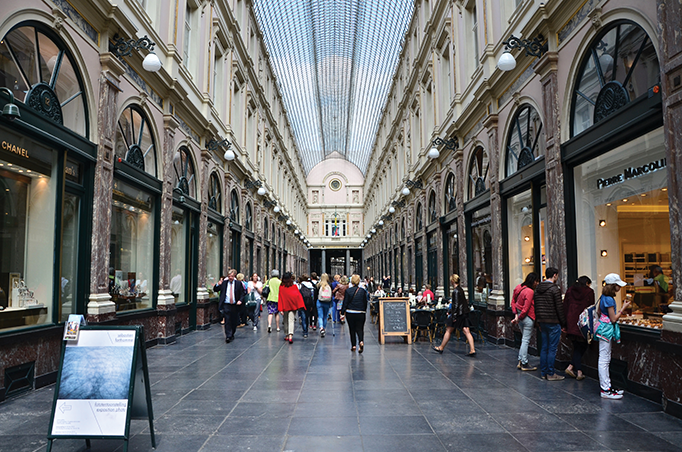
Anyone under the impression that mixed-use development and malls serving as community entertainment centres are recent innovations might want to visit Belgium and see the elegant Galeries Royales Saint-Hubert, in Brussels — a retail, entertainment, office and apartment complex that turned 169 last June. Belgian architect and developer Jean-Pierre Cluysenaar drew up plans in 1837 for Galeries Royales — three interlinked, covered shopping arcades that would connect two of Brussels’ busiest shopping streets: the rue de la Madeleine and the rue Neuve. But then it took him nearly a decade, including 18 months of construction, to realize the project.
These days the Galeries Royales attracts 6 million visitors per year, according to manager Nancy Claessens. This is none too shabby, considering that the population of Belgium is only 11.2 million. Like the recently restored Burlington Arcade, in London, and Italy’s Galleria Vittorio Emanuele II, in Milan, this 19th-century shopping centre with its cast-iron-and-glass roof and its quaint storefronts is not only a historical curiosity, but also a solidly performing property.
Besides Cluysenaar’s forethought and the centre’s extraordinarily stable management (the current owners are descendants of Cluysenaar and his partners), the centre has benefitted in recent years from a program of renovation and some gradual changes to the tenant mix. Over the past five-plus years, Cushman & Wakefield has been working with Galeries Royales managers to add some internationally known brands to the mix of local names. Though local brands still predominate, global brands such as Longchamp and Le Pain Quotidien have taken space.
“We’ve been helping them get more professionally structured, with good brands and good names,” said Jonathan Delguste, a Brussels-based leasing agency partner with Cushman & Wakefield. “Now it’s almost fully leased and filled with solid brands.”
Though the Galeries Royales remains a prime tourist stop, as much for its historical associations as for its chocolate shops — 19th-century Symbolist poet Paul Verlaine bought the revolver he used to shoot fellow poet Arthur Rimbaud here — the centre’s manager says the combination of stores and apartments also gives the place a strong feeling of community. “It’s like a little town in a great city,” said Claessens.
Apparently, the arcades have always had a special atmosphere. Back in the 1840s, they offered Brussels shoppers a fundamentally new experience. In the daytime the passages were illuminated by sunlight pouring through the arched glass ceiling, and after dark the light came from gas lamps. “At night there was a constant movement of people to and fro, drawn by the theatre, the café-concert and the beautifully lit shop windows,” wrote Anneleen Arnout, a scholar at the University of Antwerp, in an article on the development of shopping malls in 19th-century Belgium. Among the mall walkers there was French poet Charles Baudelaire, who, during his time in Brussels, would walk back and forth along the passages eight times every day for exercise.
From the beginning, most Brussels residents liked what Arnout has called “a miniature universe” under a single roof, and the centre stayed filled day and night. One German expat, however, was less enthusiastic. Karl Marx, who sometimes held meetings nearby, criticized the city’s decision to raze a slum to replace it with a frivolous luxury-goods market in 1847.
And yet Cluysenaar’s vision of the urban future seems to have proved more durable than that of the co-author of The Communist Manifesto. Despite two world wars and multiple revolutions in Europe, as well as serious social problems in Brussels even today, people keep finding their way to this 60-store, 100-apartment complex.